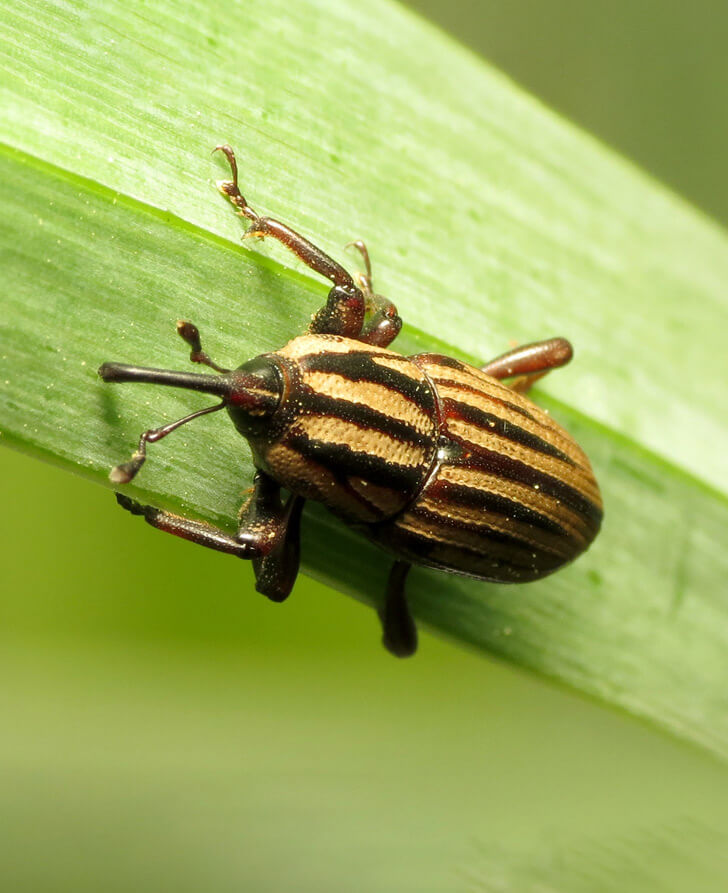Billbugs Overview
Billbugs are a broad category of species that infest grasses in residential lawn areas across the United States. Other types of grasses they are fond of are tall fescue, Kentucky bluegrass, perennial ryegrass and fine fescue. Not to mention that they love corn as well. Adult billbugs and nymphs both cause extensive damage to grasses as they start feeding in the stem working their way down the roots of turf grasses.
GET A QUOTE NOWIdentification
Adult billbugs are known as the weevil in the insect family. Most of them are 1/2 inch long making them difficult to find in turf however they tend to walk on the sidewalks when the temperature gets warm during spring. Depending on the species, the hard shells may be a grey, brown or black color with a rough texture on their back. They have 6 legs and antennae like most beetles do. Nymphs are usually white, with no legs and a brown capsule-shaped head.
Main Service Areas For Billbugs Removal
-
 Boca Raton Billbug Control
Boca Raton Billbug Control
-
 Boynton Beach Billbug Control
Boynton Beach Billbug Control
-
 Lake Park Billbug Control
Lake Park Billbug Control
-
 Lake Worth Billbug Control
Lake Worth Billbug Control
-
 Palm Beach Gardens Billbug Control
Palm Beach Gardens Billbug Control
-
 Palm Beach Billbug Control
Palm Beach Billbug Control
-
 Palm Springs Billbug Control
Palm Springs Billbug Control
-
 Riviera Beach Billbug Control
Riviera Beach Billbug Control
-
 South Bay Billbug Control
South Bay Billbug Control
-
 South Palm Beach Billbug Control
South Palm Beach Billbug Control
-
 West Palm Beach Billbug Control
West Palm Beach Billbug Control
-
 West Lake Billbug Control
West Lake Billbug Control
-
 Coral Springs Billbug Control
Coral Springs Billbug Control
-
 Fort Lauderdale Billbug Control
Fort Lauderdale Billbug Control
-
 Pompano Beach Billbug Control
Pompano Beach Billbug Control
-
 Coconut Creek Billbug Control
Coconut Creek Billbug Control

Life Cycle
Unlike many other pests, billbugs complete only one generation annually but may vary depending on the species. Adults spend their winter in decomposing leaves and dried plants most of the time before becoming active from April to May when the temperature becomes pleasant.
Adult female billbugs lay oval-shaped eggs in the grass stem. After 1-2 weeks, legless white larvae hatch from the eggs. These nymphs will go through 3 larval instars in which the first two weeks will be spent feeding in the grass stems. In the second larval instars, the nymphs break out of the stem. The larval stage will be completed within 5-8 weeks and they will develop into pupae around 1 to 2 inches long and change color from white to brown. Adults emerge after 7 to 10 days and will continue feeding on host plants until they find a place to overwinter.
Signs & Damage
Billbugs feed on grasses and crops in the house garden. The damages arise when these insects puncture the stem to deposit eggs and suck the plant juices. Larvae eat the plant stems going through the roots that are below the soil. Damage is characterized by brown-colored spots that do not turn green after being properly watered.
Damages caused by billbugs are difficult to determine as they are closely similar to drought damage or fungal disease. However, you can perform a test by pulling or digging the grass to examine the roots and crown also this will make the larvae noticeable.
Treatment
To control an infested lawn, you can use biological control products and organic insecticides to eliminate the billbugs in your yard. Another way is to use a lawn care method that decreases the development of dry plants and improves grass health. If none of these methods works, calling a reputable pest controller is your way to go.
GET A QUOTE NOWLicensed, Trusted Pest Control Services
At Fleming Lawn and Pest Services, we protect your home or business with superior care. Unlike the “Big Pest Control companies” we don’t pay our technicians based on how many locations they treat in a day.